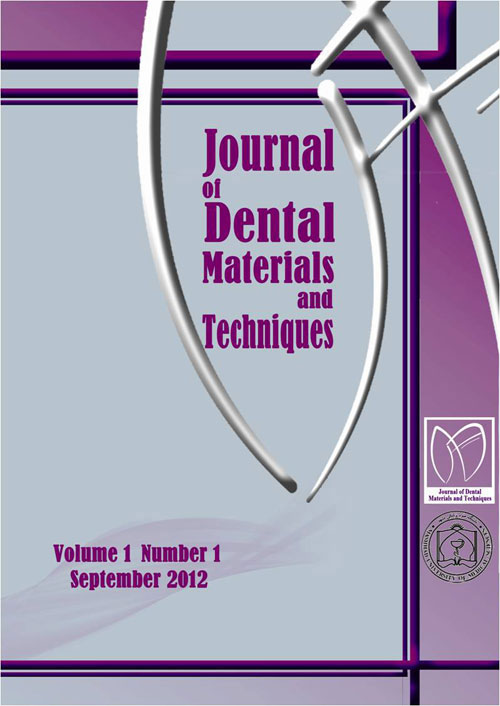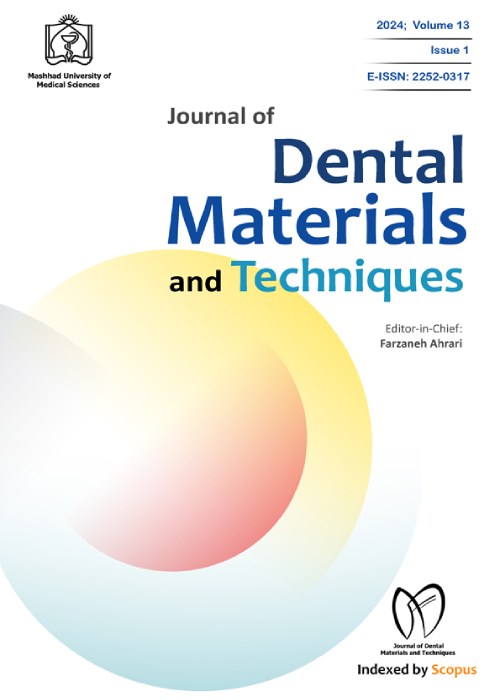فهرست مطالب

Journal of Dental Materials and Techniques
Volume:9 Issue: 2, Spring 2020
- تاریخ انتشار: 1399/06/01
- تعداد عناوین: 8
-
-
Pages 56-62IntroductionAmalgam, which can be applied with or without dowel, is one of the commonly used restorative materials for core restoration in pulpless teeth. The current study aimed to compare the shear strength of amalgam cores with and without dowel.MethodsA total number of 20 recently extracted mandibular premolars were assigned to two groups of 10 equal specimens, including group I: dowel amalgam restored with prefabricated dowel and amalgam core and group II: post-amalgam restored with amalgam as a post and core. All Specimens were stored at humidity and room temperature prior to testing. Each specimen was carefully placed in a special jig at a 90-degree angle to the axis of teeth and subjected to a load that was recorded in kgf on a Zwick/material testing machine at a crosshead speed of 0.5 mm/min until failure. Independent T-test was used to compare the results.ResultsBased on the obtained results, the mean shear strengths were reported as 37.7±10.49 and 16.8±6.37 kgf for dowel amalgam and post-amalgam, respectively. There was a statistically significant difference between the two groups (P<0.0001).ConclusionsThe obtained results demonstrated a significant difference between the two groups. Accordingly, the use of dowel with amalgam to restore pulpless teeth has higher compressive strength, as compared to the use of post-amalgamKeywords: Dowel amalgam, Post Amalgam, Shear strength
-
Pages 63-68Introduction
Among different non-invasive approaches for determining the stability of the implant within the bone is to use a dynamic device called Periotest®.It is designed to provide objective measurement of tooth mobility. The aim of the present study is to evaluate the stress transfer and stability in short and standard dental implants using Periotest® device.
MethodsThis study evaluated 15 short and 15 standard implants for non-systemically compromised patients who were candidates for dental implant. After the implant insertion, the Periotest Value (PTV) index was measured by the Periotest® device in two periods, three month after implant installation when the healing abutment was placed and six months after permanent restoration. The stability was measured by Periotest®, and the obtained numbers were analyzed by the Wilcoxon test.
ResultsThe mean values of PTVs in the group of short implants were as much as -1.13±0.91 and -1.46±0.91 before and after loading, respectively. Moreover, the mean values of PTVs in the standard implant group were as much as -1.6±1.12 and -1.8±0.67 before and after loading, respectively. The difference between short implants before and after loading was not significant. Furthermore, the PTVs in standard implants showed no significant difference before and after loading. Also there was no significant difference between short and standard implants at both times before and after loading.
ConclusionThere is no significant difference between short and standard implants in terms of stability; therefore, they can be a good alternative to standard implants in atrophic jaws.
Keywords: Periotest®, Short Implant, Standard Implant -
Pages 69-75Introduction
Glass ionomer and polycarboxylate cement have different effects on the marginal seal, microleakage, pulp tissue stimulation, and gingival health. The purpose of this study was to assess the effect of these cement on the gingival health of primary molars restored with stainless steel crowns (SSC).
MethodsA total number of 34 children were selected who were within the age range of 4-7 years and required SSCs on both sides. The selected teeth were identical in terms of the dental arch and tooth number. After preparing the teeth, glass ionomer and polycarboxylate were used randomly on each side to cement SSCs. After placing the crowns, parents were asked to maintain the oral hygiene of their children by brushing and flossing their teeth. Subsequently, 6 months after the crown cementation, the gingival index, plaque index, and additional cement were evaluated. Statistical analysis was performed in SPSS software (version 25) using Wilcoxon Rank, Chi-square, and binary logistic regression tests.
ResultsThere was more gingival inflammation in the group of teeth that used polycarboxylate as cement (P=0.022) and in the lower arch (P=0.007). The plaque index was significantly lower 6 months after the crown cementation (P<0.001).
ConclusionBased on the results, gingivitis is less prevalent in primary molars with SSCs cemented with glass ionomer. Moreover, maxillary primary molars have a lower rate of gingivitis after placing SSCs. Besides, gender and tooth numbers did not affect the gingival health of primary molars restored with SSC.
Keywords: gingival index, Glass ionomer cement, plaque index, polycarboxylate cement, primary molar, stainless steel crown -
Pages 76-80IntroductionIt may be necessary to make some modifications to the removable space maintainers for the persuasion of children to use this device. However, modification of the polymethyl methacrylate (PMMA) may affect its mechanical properties as well. Therefore, the present study aimed to evaluate the effects of color and glitter on the flexural strength of PMMA.MethodsFor the purposes of the study, 40 PMMA specimens (64 mm×10 mm×2.5 mm) were prepared and divided into 4 groups (n=10). For all groups, PMMA resin was mixed according to the instructions provided by the manufacturers. Group 1 was prepared with clear resin and served as the control group. Group 2 was prepared with clear resin and glitter. Group 3 was prepared as colored by adding color concentrate. Group 4 was colored similar to Group 3 and glitter was added as well. Finally, a three-point flexure test was used to measure the flexural strength of the specimens. The flexural strength was analyzed using the Kruskal–Wallis test. The Conover-Iman test of multiple comparisons was used to detect the differences among the groups. In all the tests, a P-value of 0.05 was considered statistically significant.ResultsThe PMMA with glitter showed statistically significant reduced flexural strength value, compared to clear PMMA. Moreover, the addition of color caused an insignificant increase in the flexural strength of PMMA.ConclusionThe addition of glitter to clear PMMA reduced the flexural strength of the material while other modifications did notKeywords: Coloring, Flexural strength, PMMA, Space Maintainer
-
Pages 81-87IntroductionMetal-supported porcelain crowns (MSPC) and bridge restorations may be present in the mouths of patients undergoing CBCT imaging. Artifacts that are caused by these MSPCs may adversely affect image quality. The aim of this study is to determine the effect of different FOV (field of view) and localization in FOV on metal artifacts caused by MSPC.MethodsTwenty MSPCs scanned with CBCT at central and peripheral localization at 18x16 and 8x8 cm FOV. The 2.5 mm periphery area of the MSPC cross-sectional image was evaluated. The metal artefact-area within this area was measured. Then, the artifact-area to total-area ratio was converted to form of a percentage. In addition to evaluation of crown periphery area, the lengths of the metal streaks artifacts were measured. The maximum linear dimension of the metal artifact was recorded from the crown margin for each MSPC in cross-sectional image in the bucco-lingual direction. All data collected were evaluated by Kruskal-Wallis analysis and Mann Whitney U test (P˂0,05).ResultsNo statistically significant differences were found in the artifacts-area measured (P=0.121). However, there was a statistically significant difference in linear dimension measurements of artifacts (P=0.000). In 18x16 cm FOV localization peripheral linear dimension measurements were higher than other FOV and localizations.ConclusionLinear size artifacts of MSPC were found to be higher in peripheral positioning in wide FOV. However, according to this study, areas evaluated for metal artifacts caused by MSPCs are not affected by FOV and localization.Keywords: CBCT, dental image quality, metal crown, Metal Artifact, FOV, In-vitro study
-
Pages 88-94Introduction
Glass ionomer cement (GIC) is a dental restorative material that is prone to solubility and degradation. GIC could degrade in presence of water and desiccation due to environmental factors during setting process and eventually might lead to the failure of the restoration. Cigarette smoking brings a complex chemical mixture to oral cavity that can inhibit polymerization and promote the solubility of this cement. Therefore, the aim of this study was to evaluate the effect of cigarette smoking on solubility and disintegration of resin-modified glass ionomer cement (RMGIC).
MethodsRMGIC used for preparation of control group (n=54) with same number of samples in test group (n=54). The test groups were exposed to cigarette smoking. Samples divided in groups of 6 to immerse in three different mediums (water, normal saline and qahwa, the Arabic tea) for the immersion periods of 1h, 24h and 7days. Differences in weight of each sample were recorded before and after immersion. One Way Anova followed by Tukey- Kramer multiple comparison test was used to analyze data.
ResultsTest group exhibited significant dissolution irrespective to the type of medium or duration of immersion. Therefore, exposure to direct or indirect cigarette smoking within the first hour of the setting time of RMGIC cause dissolution of it. In addition, consumption of qahwa, within one hour of cement placement causes initial dissolution in both control and test groups.
ConclusionCigarette smoke exposure and consumption of qahwa drink within the initial hour of cement placement is not recommended.
Keywords: Cigarette smoke, Glass ionomer cement, solubility -
Pages 95-101IntroductionThis study evaluated microleakage of flowable and conventional composite in primary molar class II restorations using self-etch and total-etch bonding agents.MethodsClass II standard cavities were prepared on proximal surface of 48 primary molars. These cavities were restored using GrandioFlow and Grandio composites and Futurabond DC and Solobond M as bonding agents. Teeth apices were sealed by wax and two-layer nail varnish was applied up to 1mm of restoration margins. Samples were subjected to thermocycling, stained by silver nitrate solution and sectioned mesiodistally. Microleakage was measured from the tooth-restoration margin to end point of dye penetration using a stereomicroscope with a 0-3 scale. Microleakage scores were analyzed using Kruskal-Wallis test in 4 groups and paired comparisons were performed using Monte Carlo test.ResultsMicroleakage was seen in all composite and bonding agent groups. Pairwise comparison showed no significant difference regarding the microleakage between groups ( P>0.05) .ConclusionGradioflow as a flowable composite and Futurabond DC as a self-etch bonding agent both showed acceptable results in regard to microleakage. Considering the ease of application of flowable composites compared to conventional ones and shortening the treatment both flowable composites and self-etch bonding agentshave showed promising results in pediatric dentistryKeywords: Bonding Agents, flowable composites, Microleakage, Primary molars
-
Pages 102-106Introduction
In orthodontic treatment, adequate anchorage is necessary to move the intended teeth. In some cases, just anterior teeth are malaligned, while posterior occlusion is acceptable. Therefore, the posterior teeth could be integrated by fiber-reinforced composite (FRC) to provide a rigid anchorage. This method proved advantageous since brackets are bonded just to anterior segment, while posterior segments remain intact.
Case descriptionThe current article presents the orthodontic treatment of an adolescent girl with malalignment and rotation of upper incisors and canines. Posterior occlusion was admissible. Posterior anchorage was provided by FRC bars, while anterior teeth alignment was performed by routine fixed orthodontic appliances. Orthodontic treatment was completed within six months. It is worthy to note that the posterior occlusion was maintained as before treatment.
Keywords: FRC, Orthodontics, Anchorage procedures


